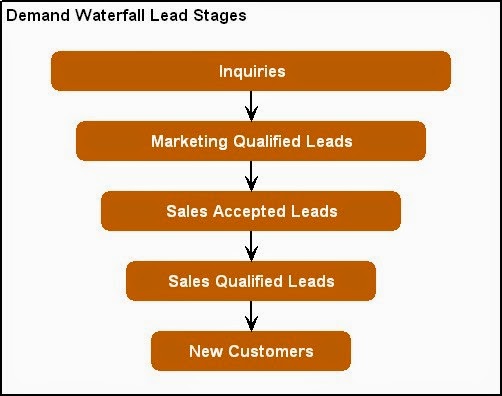- Volume - Are our marketing programs generating a sufficient number of raw leads (sometimes called inquiries or engaged contacts or responses) to produce the amount of revenue that marketing is responsible for?
- Conversion - What percentage of leads are progressing or "converting" from each lead stage to the next across the entire lead-to-revenue cycle?
- Velocity - How long is the overall revenue cycle? In other words, how much time does it take, on average, for an initial response or inquiry to result in a closed sales? Funnel metrics can also measure how long, on average, leads spend in each stage of the lead-to-revenue cycle.
When I'm working with clients on lead generation/lead nurturing programs, I usually recommend that they use the Demand Waterfall model developed by SiriusDecisions to describe the major stages of the lead-to-revenue cycle. The graphic below shows the major components of the Demand Waterfall. SiriusDecisions recently revised the Demand Waterfall model to add several lead stages, but the framework shown below is still widely used, and I actually prefer to use the simpler version when companies are just beginning to track and measure the performance of their demand generation system.
When the topic of conversion rates comes up in conversations with clients, the question they inevitably ask is: What should our target conversion rates be? This question is always difficult to answer because conversion rates can vary greatly depending on the type of business involved, and I've never seen reliable conversion rates for specific industries or types of business. Plus, the most important thing is to determine what your current conversion rates are, and then look for ways to improve them.
While broad-based conversion rates should be used cautiously, they can provide a useful reference point. The table below shows benchmark conversion rates recently published by SiriusDecisions and the Aberdeen Group. The SiriusDecisions rates are from a 2014 presentation given by Laura Cross, a Research Director with SiriusDecisions. The Aberdeen conversion rates are from a 2014 research report titled Marketing & Sales Performance: The Roadmap to Revenue & Its Tollgates.
This table uses the lead stage terminology from the SiriusDecisions Demand Waterfall. Aberdeen Group uses different terms for some lead stages, but I believe the table is accurate based on how Aberdeen defines lead stages.
As I noted earlier, lead conversion rates can vary significantly depending on the type of business you're in, and the conversion rates shown above may not reflect your business situation. However, they will provide a good starting point for setting your conversion rate objectives.
This table uses the lead stage terminology from the SiriusDecisions Demand Waterfall. Aberdeen Group uses different terms for some lead stages, but I believe the table is accurate based on how Aberdeen defines lead stages.
As I noted earlier, lead conversion rates can vary significantly depending on the type of business you're in, and the conversion rates shown above may not reflect your business situation. However, they will provide a good starting point for setting your conversion rate objectives.






How do you account for such a large difference in the two sets of numbers?
ReplyDeleteM